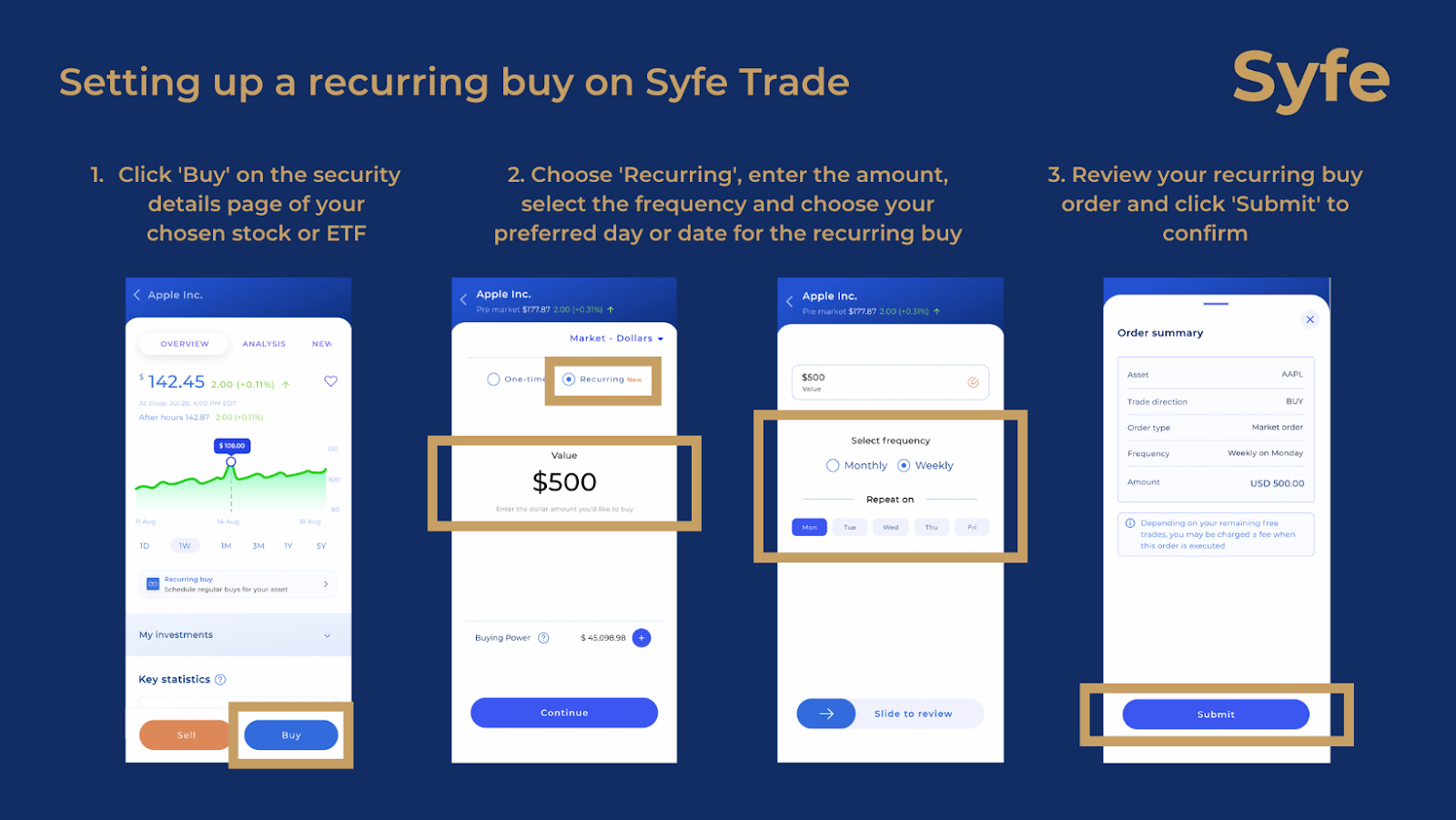
The S&P 500 jumped 9% in July, buoyed by better-than-expected corporate earnings and a rebound in tech heavyweights like Tesla, Apple and Amazon.
Curious to know what investors bought during the July rally? Check out the top 10 traded stocks on Syfe Trade below.
Planning to dollar cost average into these popular stocks? You can now do so easily through Syfe Trade’s recurring buy feature! This new feature enables you to automatically invest in a particular stock or ETF every week or month. Just buy the stock as usual and click on the “Recurring” button to enable the feature.
When you dollar cost average, you’re buying into the market regularly at different prices. Over time, your purchase price averages out. This is a long-term investing strategy that can also help smooth out the impact of market volatility. For example, if the stock price goes down, you’ll be able to scoop up more shares with your weekly or monthly investment.
1: Tesla
Tesla’s stock price jumped 32% in July, offsetting some of its losses this year. The recovery was boosted by Tesla’s better-than-expected earnings and retail interest in Tesla stock ahead of its 3-for-1 stock split.
On Thursday, shareholders approved the stock split during Tesla’s annual shareholders meeting. The stock split will not affect Tesla’s overall market value but serves to make the stock more accessible for investors.
During the meeting, CEO Elon Musk said Tesla might announce another factory site this year and expects to build more in the future. Tesla currently has six factories worldwide in Shanghai, Berlin, and several US cities. More factories would help Tesla reach its goal of producing 20 million vehicles per year, a significant jump from the 1.5 million it currently makes each year.
In a previous earnings call, Elon Musk revealed that the highly anticipated Cybertruck is on track to launch in mid-2023. Tesla also inked two new battery material supply deals recently, a move aimed to secure sufficient battery supply to support its vehicle production targets through to 2025.
2: Apple
Apple rose 17% in July, buoyed by the broader market rally and several catalysts. Apple beat analyst expectations for revenue and profit in its fiscal third quarter. iPhone sales were better than expected, despite slowing demand for smartphones globally as consumers grapple with rising inflation.
Notably, Apple’s services business was the fastest growing segment during the quarter. It includes App Store sales and subscriptions to other offerings like AppleCare, iCloud, Apple Pay, and Apple TV+.
Beyond these established revenue drivers, new opportunities include Apple’s foray into Buy Now, Pay Later, and its next-gen version of Apple CarPlay. At a recent conference, Apple showcased a feature that enables drivers to pay for petrol top-ups using CarPlay. Just as Apple takes a slice of App Store sales, the company can potentially monetise CarPlay services as a new growth driver for Apple.
3: Alphabet
Alphabet is Google’s parent company. The stock rose 6% in July despite reporting weaker-than-expected earnings and revenue for the second quarter.
Although overall advertising revenue growth slowed, Google’s search advertising business topped expectations, suggesting that Google may weather the slowdown in advertising demand better than social media companies like Meta and Snap.
While advertising still generates the bulk of Alphabet’s revenue, the company is working to diversify into other areas. Alphabet’s cloud business, Google Cloud, grew 35% year-on-year in the second quarter. Google Cloud has also been making infrastructure investments to take market share from Amazon Web Services (AWS) and Microsoft Azure.
AWS and Azure currently have 31% and 24% market share respectively. Google Cloud’s share is only 8%, according to industry estimates.
4: Amazon
After disappointing during the first quarter, Amazon reported better-than-expected earnings for the second quarter and issued positive guidance for the third quarter.
Shares of Amazon rallied 23% in July, supported by resilience in its AWS cloud segment and a fast-growing ad business.
Notably, second quarter ad revenue jumped 18% from a year ago, beating out other online ad platforms like Google and Meta in terms of growth rates. While those platforms were affected by Apple’s iOS privacy changes, Amazon’s ad business was not. That’s because advertisers go directly to Amazon’s platform to promote their products on the company’s website and app. This also increases the probability of ads converting to direct sales.
5: Grab
Singapore super-app Grab staged a comeback in July after J.P. Morgan upgraded Grab to Overweight from Neutral. “Grab’s superior regional super-app platform is best geared to rising online consumption in ASEAN, in our view,” the investment firm said.
Grab’s upcoming second quarter earnings on 25 August could provide another catalyst. Grab’s stock price jumped more than 24% after the company reported better-than-expected revenue figures in the first quarter.
Revenue during the first quarter rose 6% year-on-year, supported by a recovery in ride-hailing demand as the pandemic receded. Grab also narrowed its net loss to $435 million despite still offering a lot of incentives for partners and consumers as it seeks to expand market share.
6: Alibaba
Alibaba faced several headwinds in July. The company was added to the US Securities and Exchange Commission’s delisting watchlist, joining other US-listed Chinese stocks such as JD.com and Pinduoduo. The move came just days after Alibaba announced it would seek a primary listing in Hong Kong.
However, the stock has been boosted recently by its better-than-expected first quarter earnings. Despite slowing economic growth in China, Alibaba managed to avoid a sharp drop in revenue. The Chinese e-commerce giant reported flat revenue growth which beat analyst estimates. Additionally, Alibaba said consumer sentiment began recovering from June and picked up further in July.
“The results signal resilience in the face of regulatory fears and domestic economic headwinds,” according to a research note from Global X Management Co. “Chinese tech stocks still have room for recovery with valuations at attractively cheap levels and an easing policy environment continuing for the foreseeable future. But there is still a dose of caution, as investors get a little spooked from time to time.”
7: Meta
Meta ended the month of July largely flat. Although shares fell after the company reported disappointing earnings, Meta benefited from the broader tech rally last month.
That said, recent company news hasn’t been positive. Sales in the second quarter fell almost 1% from a year ago, its first-ever yearly decline in revenue. Meta’s core advertising business has been hurt by weak advertising demand and Apple’s iOS privacy update.
Meta’s pivot into the metaverse is also expected to be an expensive affair. The Reality Labs division, which develops metaverse, virtual reality (VR) and augmented reality (AR) technologies, recorded a $2.8 billion loss in the second quarter. To cope with cost pressures and a slowing economy, Meta has said it will be cutting headcount growth over the next year. The company also raised the price of its Quest 2 VR headset by $100 recently.
8: Microsoft
Microsoft shares gained 8% in July after providing rosy guidance for the next quarter. Despite economic headwinds, they still expect double-digit revenue and operating margin growth for the full year.
Microsoft has a long track record of double-digit revenue growth. For its fiscal fourth quarter, revenue growth was a solid 12%, boosted by Microsoft’s Azure cloud business. Azure revenue jumped 40%-year-over-year during the quarter.
Analysts are positive about Microsoft’s cloud business. In a note, Mizuho analyst Gregg Moskowitz wrote “Notwithstanding what is clearly a more difficult operating environment, we remain confident that [Microsoft’s] growth opportunities over the medium-term and beyond are greater than many realize, and that [Microsoft] is positioning for materially greater success in cloud.”
9: Nvidia Corporation
Shares of Nivida rallied 25% in July alongside the broader rally in semiconductor stocks.
Nvidia is a chipmaker well known for its graphics processing units (GPUs) that make video games more realistic and thrilling. Nvidia’s chips also power a range of other applications such as data centers, autonomous driving, artificial intelligence, cloud computing and bitcoin mining.
One potential catalyst for the semiconductor industry is the US CHIPS Act, which would provide over $50 billion in subsidies for US semiconductor companies to produce chips domestically. However, Nvidia may not benefit as much. The company designs its own chips but outsources the production to other companies.
Instead, the main benefactors could be Nvidia’s rival Intel, which plans to build a $20 billion advanced chip manufacturing plant in the US.
Nvidia will report its second quarter earnings on 24 August 2022.
10: NIO
NIO is a Chinese electric vehicle maker. Although shares dipped about 8% in July following the broader pullback in Chinese equities, NIO has rallied 11% over the past five trading sessions. This comes after NIO reported its July vehicle deliveries. The company delivered 10,052 vehicles in July, a 27% increase year-over-year.
Additionally, NIO is on track to open its first overseas plant in Europe next month. The facility will manufacture power products such as battery-swapping stations to support European customers. NIO plans to expand sales of its cars in countries such as Germany, Sweden, and Denmark in the second half of 2022.
NIO is likely to report its second quarter earnings in mid-August.
How to invest in Tesla and other US stocks
If you are thinking about buying Tesla stock, or any of the other top traded stocks mentioned above, you can do so easily using Syfe Trade. You’ll enjoy free trades every month and super low commissions on all trades thereafter. Find out more in this review of Syfe Trade!
As we mentioned earlier, you can now set up recurring buys on Syfe Trade too. This feature enables you to choose a scheduled day in a week or month to automatically purchase shares of your choice. This makes dollar-cost averaging into your favourite stocks so much easier.

Simply download the Syfe app now to start trading!
All views, opinions, and analyses in this article should not be read as personal investment advice and individual investors should make their own decisions or seek independent advice. This article has not been prepared in accordance with legal requirements designed to promote the independence of investment research and is considered a marketing communication. Reference in this document to specific securities should not be interpreted as a recommendation to buy or sell these securities, but is included for the purposes of illustration only. Past performance is not a reliable indicator of future results. This advertisement has not been reviewed by the Monetary Authority of Singapore.






You must be logged in to post a comment.